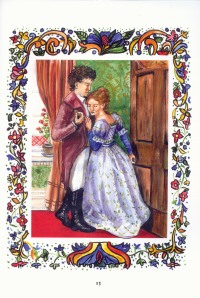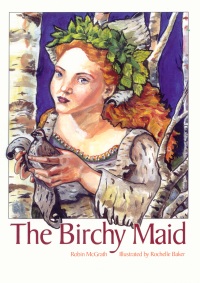| ________________
CM . . .
. Volume XIX Number 41. . . .June 21, 2013
The Birchy Maid is a fairy tale for modern sensibilities. It tells the tale of the youngest daughter of an unhappy merchant. Asked to quantify her love for her father's ledger of wealth, she expresses it in a way that is immeasurable. Displeased with her answer, her father turns her out, and she is forced to fend for herself in the forest surrounding her family's land. When she comes across a handsome house, from which is wafting the smell of fresh baking bread, she comes up with a plan to gain entry to satiate her hunger. Covering her beautiful clothes with the bark of a birch tree, she asks to work in the kitchen in return for food, and she is admitted. During a dance in honour of the son of the house, which the Birchy Maid attends sans her disguise, the son falls in love with her, and, when refused her hand in marriage, he takes to his bed. It takes the Birchy Maid's soup to bring him back from his depression, and they get married on one very specific condition: she must serve her soup at the reception. 
The classic fairy tale style of The Birchy Maid is parenthetically framed by an allusion to a young girl who is hearing the tale told at school. To my mind, these first and last pages were superfluous and jarring. That being said, the tale, itself, was whimsical and entertaining. The heroine is cunning, but she has a grace and kindness to her which is entirely endearing. We, as readers, become empathetically involved in her story. The tone and flow are perfectly suited to the style. The Birchy Maid is a highly engaging story with the ideal instance of comeuppance in the end. The illustrations are full of bright, saturated colours and complement the classic feel of the text. Especially charming are the ornately designed first letters on each page, at once unique and traditional. The pictures depict the most important moments in the story well, but they do not add anything extra to the experience of their own merit. Overall, The Birchy Maid is a wonderful example of the continuing importance and appeal of the fairy tale. Her self-reliance makes her a great role model for children, and the writing is easily accessible. Still, it would have behooved the book to have left the surrounding context (the school children hearing the story) out and to focus the full energy on the tale itself. Recommended. Amber Allen is a librarian in Toronto, ON, with a passion for children's literature.
To comment
on this title or this review, send mail to cm@umanitoba.ca.
Copyright © the Manitoba Library Association. Reproduction for personal
use is permitted only if this copyright notice is maintained. Any
other reproduction is prohibited without permission.
NEXT REVIEW |
TABLE OF CONTENTS FOR THIS ISSUE
- June 21, 2013.
AUTHORS |
TITLES |
MEDIA REVIEWS |
PROFILES |
BACK ISSUES |
SEARCH |
CMARCHIVE |
HOME |
